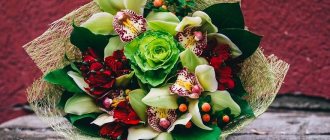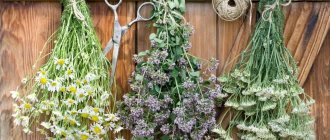What flowers can you give in November?
November in Russia is almost winter. The streets are filled with dirty grays and browns, even when the snow has already fallen. It's getting colder. Gloomy people wrap themselves in demi-season coats and think about getting a down jacket. Sad times. City flower beds can only please you with rare and faded flowers. But it is autumn flowers that could lift your spirits and get out of the off-season depression. But most October plants don't survive until November. Will we really have to wait until spring for fresh flowers? Of course not. Some plants do well even in frost.
What flowers to give in winter
Florists classify winter flowers as lilies, anthuria, roses and sunflowers. If you include one of these types in your bouquet, you definitely can’t go wrong.
Add a sprig of spruce or pine to the composition. The needles will emphasize the New Year's atmosphere of winter, and its aroma will remind you of a fabulous holiday and gifts familiar from childhood under the tree. An excellent decoration would be a physalis, a branch with pine cones, a Christmas tree toy or a colorful ribbon.
To add pleasant summer memories, you can include blooming jasmine in your bouquet. Its bright scent will remind you of the starry sky on a warm summer night and will distract you from winter melancholy.
Alpine edelweiss looks incredibly beautiful. It will turn your composition into a truly winter bridal bouquet, and its small white buds, like snowflakes, will lull the entire floral ensemble to sleep.
Annuals
Most cold-resistant flowers are among annuals. They begin flowering at the very beginning of summer and do not stop until frost.
Marigold
Marigolds, or tagetes, appeared in Europe in the 16th century, where they were brought from America by Spanish conquerors. Since then, the flowers have spread widely throughout Eurasia. Now, perhaps, there is not a single flower bed where these unpretentious bright flowers would not be.
Abundantly flowering marigolds decorate the flower garden from the very beginning of summer until frost. Their care is minimal, the main thing is to plant them in the right place - in a sunny or slightly shaded area with fertile loam.
With their pungent smell, marigolds will repel many insect pests, so we recommend planting them next to roses and gladioli. In addition, the phytoncides that this plant secretes help suppress fungi and bacteria that harm vegetable crops. For this reason, many people plant marigolds in the garden next to strawberries, nightshades, onions, cabbage, etc.
After short-term frosts, simply cut off the frozen parts - the plant will quickly recover and will delight you with its flowering until the onset of persistent cold weather.
Petunia
Among balcony garden plants, the palm belongs, of course, to petunias. The most incredible colors, long flowering period (from mid-May to frost), large flowers - all this has made it a favorite of gardeners.
Petunia will grow best in light, fertile soil. It is quite moisture-loving, but can tolerate short-term drought. But overwatering is very dangerous for the plant, because... Petunia often gets blackleg. The main thing that should not be forgotten when growing petunias is fertilizing and regularly removing faded inflorescences. Only if you follow these rules will you be able to see petunia in all its glory - strewn with bright flowers.
Calendula
Another plant that can decorate a flower garden until frost is calendula, or marigold. Plant it in a sunny place - and calendula will thank you with constant and abundant flowering, which continues, starting in June, all summer and autumn.
But this is not the only reason why the plant attracts summer residents. Calendula is a real green pharmacy. Its flowers are used to treat many diseases. The bactericidal properties of the plant are used for throat diseases and stomatitis; calming effect – for diseases of the central nervous system; Calendula-based medicines are used to treat burns and fistulas.
Decorative cabbage
Ornamental cabbage can also decorate a pre-winter flower garden. Its colorful colors appear just at low temperatures - below 10°C: the color of the leaves becomes brighter and more saturated. If you want your cabbage to look even more impressive, plant it in a sunny place. In the shade, the plant will look more like a regular cabbage rather than a flower.
Ornamental cabbage comes in two types: low-growing, which is widely used to decorate ridges and borders, and palm cabbage, reaching a height of 130 cm. In flower beds it is usually planted in the background. Plants easily tolerate short-term frosts down to –10°C and transplantation. If you want to admire ornamental cabbage for as long as possible, transplant it with a lump of soil into a pot and bring it into the house - it will continue to delight you until the New Year.
Lobularia (alissum)
Marine lobularia (also called alyssum and alyssum) is an annual with small flowers (most often white or purple) that will delight you with its flowering from the very beginning of June until frost. It is able to withstand even light frost and continue to bloom again. It easily propagates by self-sowing, so you won’t have many problems with care: loosen the soil, remove weeds and enjoy its light honey aroma.
Gatsaniya (gazania)
From July until frost, your garden will be filled with bright flowers of gatsaniya (gazania) harsh. It is native to Africa (also found in the wild in Australia), and is shaped like a daisy; For this, it received another name from flower growers - African chamomile.
African chamomile is a perennial plant. However, it cannot withstand our winter in open ground, so we grow gazania as an annual.
It is difficult to list the entire range of colors that this low – up to 30 cm – flower has. But all gazanias have one feature: their flowers open very quickly in the sun and fold their petals just as quickly on a cloudy or rainy day. For this reason, the best place to plant gazania is in a sunny area.
What flowers are best to give in spring?
Spring is a time of awakening. All people, and especially women, feel uplifted. They are looking forward to warmer weather, spring fashion, short skirts, new hairstyles. It is important to be able to emphasize this mood - the bouquet should not remind of the bygone winter, it should be fresh, light and natural.
The best way to create such a bouquet is to use spring flowers:
- Lilies of the valley;
- Snowdrops;
- Bouquet of tulips;
- Crocuses;
- Mimosa;
- Bouquet of irises;
- Lilac inflorescences;
- Daffodils.
Orange shades can be used with these colors. It could be a rose, calla lilies, orchid or carnation. You should be careful with lilies of the valley - they do not get along well with other flowers and look great on their own.
You should not decorate the bouquet with rhinestones or beads. The composition should look natural. Avoid an abundance of dark greenery; it will deprive the bouquet of lightness and airiness.
Wedding
One of the most solemn and romantic days for lovers - a wedding - is impossible without flowers. Wedding bouquets of round, linear or cascading shape will help highlight the tenderness and charm of the bride. Bridal bouquets can be made from medium-sized roses of white, cream or pale coral color, pale chrysanthemums or white tulips, as well as their combinations. The number of short-cut flowers can reach 19, and greenery can be not only a floral frame - it is often used as a long “tail” of a bride’s bouquet. Cascading bouquets suggest a combination of orchids and roses in pastel colors, while linear wedding bouquets can combine exotic flowers, even bright colors.
Flowers can be used to decorate the bride's hair, an arm bracelet and a small wedding wreath. It is better if these are small bush chrysanthemums or roses, but there are no strict criteria - the wedding dress is the determining factor.
The groom's boutonniere, which adorns his wedding suit, must match the bride's bouquet. Boutonnieres are often made from a white rose, a classic wedding flower.
Wedding floral table decorations are usually made from short-cut flowers (orchids, chrysanthemums and pale roses) to keep the bouquet small in height. Table decorations can include candles - the main thing is that their color matches the main color scheme of the flower arrangement. The walls of the restaurant hall are usually decorated with chrysanthemum wreaths.
You can give the newlyweds a basket of cream or white roses, give orchids to the parents, and celebrate the children carrying the bride's train with tiny bouquets.
What flowers to give in summer
Light bouquets are popular in summer. This is the season of vacations and night walks, open cafes and discos, sea, stars and romance. Flowers should be bright, but at the same time unobtrusive.
Chrysanthemums look great. These flowers offer a rich range of colors and you can create a very beautiful bouquet. They last a long time, are not afraid of heat and do not wither, because this is a truly summer plant.
A good choice would be a bouquet of daisies and gerberas. Chamomile will add notes of spontaneity and rustic beauty to the bouquet. Wildflowers would also be appropriate; they will emphasize the nobility of a rose or peony, while adding lightness and summer aromas.
What to add to the composition?
In November, bright autumn almost gives way to dull winter. Therefore, in an autumn flower arrangement you need to consolidate this image of a blessed autumn. What elements can be added to the flowers?
Ripe ears
The golden spike will highlight the bright flowers. They should protrude from the top of the composition so as not to get lost in the floral diversity. Even if you have nothing to do with agriculture, don't be afraid to use this symbol. The ear symbolizes not only a rich harvest, but also fertility and prosperity.
Twigs with berries
Such decoration has double benefits - beauty and the opportunity to eat this part when everything else has faded. Blackberries, raspberries, rowan - all this can still remain on the bushes until November and bide their time.
Box with gifts of nature
If you arrange the composition not in the form of a bouquet, but in a box or basket, you can add autumn fruits and vegetables there. Apples and pears will fit perfectly into a flower arrangement. So are small pumpkins, ears of corn or sunflower caps. If everything is arranged correctly, the result will not be rustic chic, but a luxurious autumn composition with edible elements.
How to arrange all this beautifully?
In design, it is also worth remembering the proximity to nature. Burlap may look rough, but flowers wrapped in it will look original. Kraft paper and felt are also not the most elegant materials, but when combined with a floral arrangement they seem more delicate. Floral mesh can also be used here, but so that its color contrasts with the color of the bouquet. And twine is perfect for securing the stems. Choose any kind of baskets and boxes - they were originally invented for autumn compositions. Or entrust the design to professionals. For example, from the My Flowers online store. Florists work here who will select the best design for flowers.
What flowers to give in the fall
Autumn bouquets should be colorful. At this time, all nature dresses up, and your bouquet should not lag behind. The emotions of the past summer, the energy of the new working season and the anticipation of cold weather should be combined here.
The best options for making bright autumn bouquets are:
- Asters. Blue, red, purple, white, yellow and orange - they are perfect for autumn like no other;
- Zinnias. These flowers are also distinguished by their rich colors, and a small flower will make the bouquet colorful and cheerful;
- Chrysanthemums. Branches with several inflorescences will make the composition more lush and full;
- Peonies. Delicate and fragrant, these flowers will remind you of summer days and make the bouquet brighter.
Add maple leaves and rowan berries to your palette. This will emphasize your originality and make the composition truly fall. Be bolder, experiment more often - and your woman will always be in a good mood!
Birthday
The largest number of flowers are given on birthdays. What flowers should I give a woman? Of course, beloved ones. Or extravagant - for example, purple carnations or tulips - such a bouquet will not go unnoticed. But, if you are not entirely sure of your choice, then give a classic bouquet of roses or a branch of an exquisite orchid. This will keep the birthday girl in high spirits.
Just remember that if you are giving a bouquet to an elderly woman, do not take flowers in dark colors - the same roses, for example, burgundy, can be diluted with white or yellow flowers.
If your recipient is a girl, give him a bouquet of unblown, short-cut roses in white or pink, and if the hero of the occasion is a man, then give him large, bright flowers on a long stem. You can choose green or red anthurium, yellow gladioli, or chrysanthemums. Exoticism would also be appropriate - elongated leukosperums and strelitzia are also considered “male flowers”. The main thing is that the main rule of a men's bouquet is observed - the central vertical.









